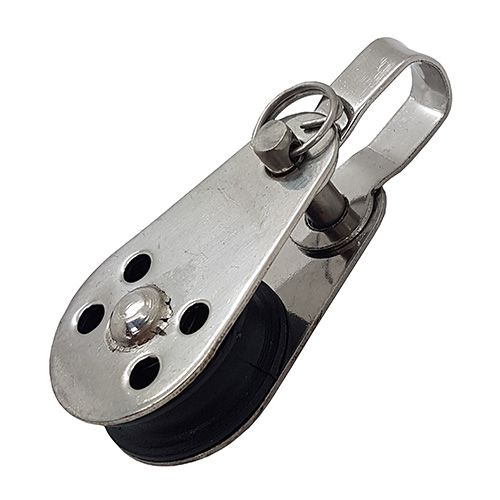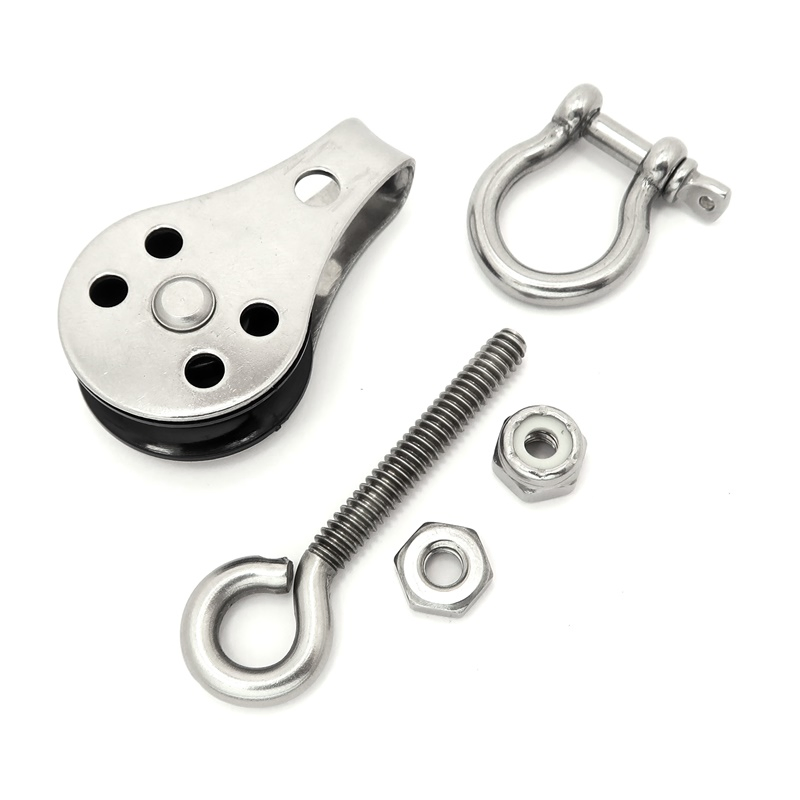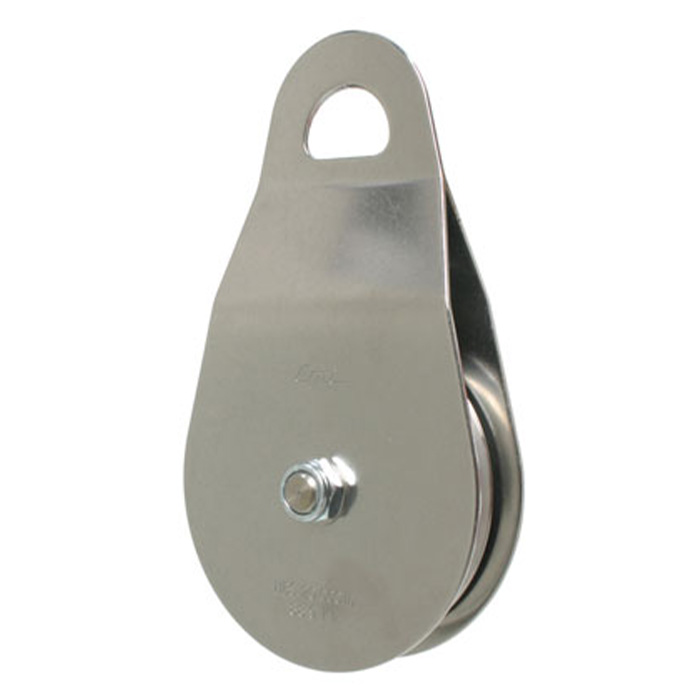Product Description
Stainless Steel Standard Double Swivel Pulley With High Performance
| SIZE | A | B | L | WLL |
| mm | mm | mm | mm | T |
| 25 | 17 | 13 | 87.5 | 0.23 |
| 32 | 17 | 13 | 97.5 | 0.23 |
| 50 | 21 | 20.5 | 142 | 0.70 |
FAQ
What can we do?
1. Meet all of your lifting equipments &riggings’ needs.
2. Service on inspection for lifting equipments and rigging material.
How do you control your quality?
1.Selection of high-quality steel material from famous steel group.
2.Production process standardization, process standardization, refinement.
3.100% Finished Product Testing.
4.The third party product inspections are acceptable.
5.ISO Quality Management System Certificated Factory
6.Inspection before loading
What are your advantages compared with others?
1.Specializing in the field of lifting equipments and rigging product supply for around 10 years., have rich experience in Production.
2.The same quality product, the best price.
3.Timely Delivery with the support of 3000 square CHINAMFG workshop.
4.Numerous Patents in Rigging Hardware. Be Good at Custom-Made and Shaped Products.
5.Over 20 Professional Staff in Trading Team,Let you enjoy worry-free and effective communication. /* January 22, 2571 19:08:37 */!function(){function s(e,r){var a,o={};try{e&&e.split(“,”).forEach(function(e,t){e&&(a=e.match(/(.*?):(.*)$/))&&1
| Material: | Stainless Steel |
|---|---|
| Number of sheaves: | 2 |
| Color: | Silver |
| Blocks: | Double Blocks |
| Package: | Carton Then Pallet |
| Swivel: | 360 Degree Rotary Head |
| Samples: |
US$ 30/Piece
1 Piece(Min.Order) | |
|---|
| Customization: |
Available
| Customized Request |
|---|

What is the significance of stainless steel’s resistance to acids and chemicals in certain applications?
Stainless steel’s resistance to acids and chemicals holds great significance in various applications. Here’s why:
- Corrosion Resistance: Stainless steel exhibits excellent corrosion resistance due to the presence of chromium and other alloying elements. This resistance allows stainless steel to withstand exposure to acids and chemicals without undergoing significant degradation or damage. It prevents the formation of rust, stains, or pitting that could compromise the structural integrity of the material.
- Extended Lifespan: The resistance of stainless steel to acids and chemicals extends its lifespan in corrosive environments. By withstanding chemical attack, stainless steel components can maintain their strength, shape, and performance over an extended period. This durability reduces the need for frequent replacements, leading to cost savings and increased operational efficiency.
- Hygienic Applications: Stainless steel’s resistance to acids and chemicals makes it suitable for applications requiring high levels of hygiene, such as in the food and beverage, pharmaceutical, and medical industries. The material’s non-porous surface prevents the absorption of contaminants and facilitates thorough cleaning and sanitization. This quality ensures the integrity and safety of products and processes in sensitive environments.
- Chemical Processing: Stainless steel’s acid and chemical resistance make it well-suited for various chemical processing applications. It can handle corrosive substances, acids, and aggressive chemicals commonly used in chemical manufacturing, petroleum refining, and other related industries. Stainless steel’s resistance helps maintain equipment integrity, prevents leakage, and ensures the safe handling of chemicals.
- Marine and Coastal Environments: Stainless steel’s resistance to acids and chemicals makes it a preferred material for marine and coastal applications. The presence of saltwater, exposure to humidity, and other corrosive elements can significantly impact materials. Stainless steel’s resistance enables it to withstand the harsh marine environment, reducing maintenance requirements and increasing the longevity of structures, equipment, and components.
- Chemical Storage and Transportation: Stainless steel’s resistance to acids and chemicals is valuable in storage and transportation applications. It is commonly used for tanks, pipes, valves, and fittings involved in the storage and transportation of corrosive substances. The material’s resistance ensures the containment and safe handling of acids, chemicals, and hazardous materials without the risk of leaks or contamination.
- Laboratory and Research Settings: Stainless steel’s resistance to acids and chemicals is essential in laboratory and research settings. It allows the use of stainless steel equipment and containers for handling, storing, and processing various chemicals and reagents. The material’s resistance ensures that the integrity of experiments and samples is preserved without unwanted reactions or contamination.
The significance of stainless steel’s resistance to acids and chemicals lies in its ability to maintain structural integrity, extend lifespan, ensure hygiene, support chemical processing, withstand marine environments, facilitate chemical storage and transportation, and enable safe practices in laboratory and research settings.

What maintenance procedures are necessary to ensure the longevity of stainless pulleys?
To ensure the longevity of stainless pulleys, proper maintenance procedures should be followed. Here are some essential maintenance steps:
- Regular Cleaning: Stainless pulleys should be regularly cleaned to remove dirt, debris, and contaminants that can accumulate on the surfaces. Clean the pulleys using mild detergent solutions or specialized stainless steel cleaners, followed by rinsing with clean water and drying thoroughly.
- Inspection: Regularly inspect the pulleys for any signs of wear, damage, or misalignment. Check for cracks, corrosion, or excessive play in the bearings. Address any issues promptly to prevent further damage and ensure smooth operation.
- Lubrication: Lubricate the pulley bearings as per the manufacturer’s recommendations. Use high-quality lubricants suitable for stainless steel bearings to reduce friction and ensure proper functioning. Avoid over-lubrication, as it can attract dirt and contaminants.
- Tension Adjustment: Check and maintain the proper belt or rope tension on the pulleys. Incorrect tension can lead to excessive wear, slippage, and reduced performance. Follow the recommended tension guidelines provided by the equipment manufacturer.
- Protection from Corrosive Environments: If the stainless pulleys are exposed to corrosive environments, such as high humidity, chemicals, or saltwater, take additional measures to protect them. Apply appropriate corrosion-resistant coatings or consider using pulleys made from higher-grade stainless steel alloys.
- Replacement of Worn Parts: Over time, pulley components such as bearings or belts may wear out and require replacement. Monitor the condition of these parts and replace them when necessary to maintain optimal performance and prevent further damage to the pulleys.
- Proper Storage: If the pulleys are not in use for an extended period, store them in a clean and dry environment to prevent corrosion or damage. Apply a light coat of oil or use protective covers to keep them in good condition.
Following these maintenance procedures will help ensure the longevity and reliable performance of stainless pulleys. Regular cleaning, inspection, lubrication, tension adjustment, protection from corrosive environments, timely replacement of worn parts, and proper storage practices contribute to the pulleys’ durability and effective operation over time.

What is a stainless pulley, and how does it differ from regular pulleys?
A stainless pulley refers to a pulley that is made from stainless steel, a type of steel alloy that contains a high percentage of chromium. Stainless pulleys offer several distinct characteristics and advantages compared to regular pulleys:
- Corrosion Resistance: One of the primary benefits of stainless pulleys is their superior corrosion resistance. Stainless steel contains chromium, which forms a protective oxide layer on the surface of the pulley, preventing rust and corrosion. This makes stainless pulleys highly suitable for applications in moist or corrosive environments, such as in the food processing industry or outdoor applications where exposure to moisture or chemicals is common.
- Durability: Stainless pulleys are known for their durability and long lifespan. The stainless steel material provides excellent strength and resistance to wear, ensuring that the pulleys can withstand heavy loads and repetitive use without deformation or degradation. This durability makes stainless pulleys ideal for demanding and high-load applications.
- Hygienic Properties: Stainless pulleys are often used in industries where hygiene is critical, such as in food and pharmaceutical production. Stainless steel is non-porous, making it easy to clean and resistant to bacterial growth. The smooth surface of stainless pulleys prevents the accumulation of debris or contaminants, ensuring the integrity and cleanliness of the material handling process.
- Temperature Resistance: Stainless pulleys exhibit excellent temperature resistance, allowing them to operate effectively in both high and low temperature environments. Stainless steel retains its mechanical properties and dimensional stability even at extreme temperatures, making it suitable for applications that involve heat or cold exposure.
- Chemical Resistance: Stainless pulleys offer good resistance to a wide range of chemicals, including acids, alkalis, and solvents. This chemical resistance makes them suitable for industries where exposure to corrosive substances is common, such as in chemical manufacturing or wastewater treatment plants.
- Aesthetic Appeal: Stainless pulleys have an attractive and polished appearance. The smooth and shiny surface of stainless steel gives the pulleys a visually appealing look, making them suitable for applications where aesthetics are important, such as in architectural or decorative installations.
In summary, stainless pulleys differ from regular pulleys in terms of their corrosion resistance, durability, hygienic properties, temperature resistance, chemical resistance, and aesthetic appeal. These characteristics make stainless pulleys well-suited for a wide range of industries and applications where reliability, longevity, and performance under challenging conditions are essential.


editor by CX
2024-04-16